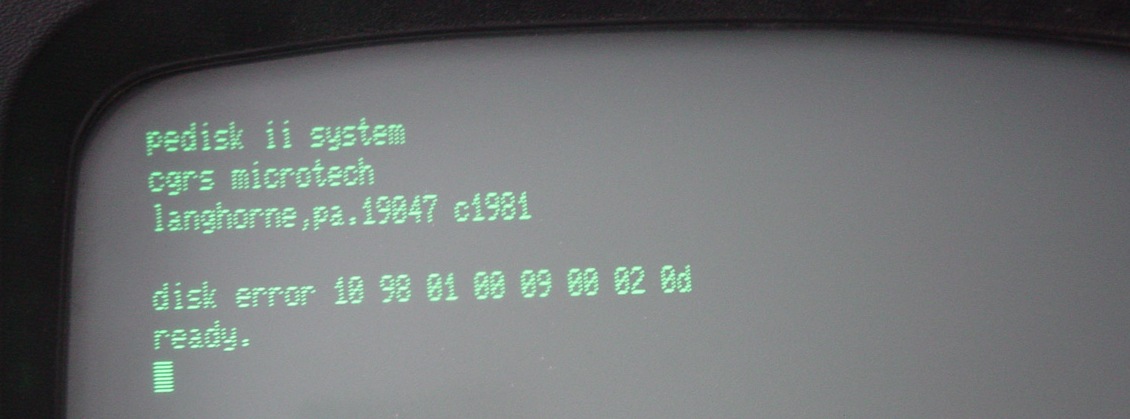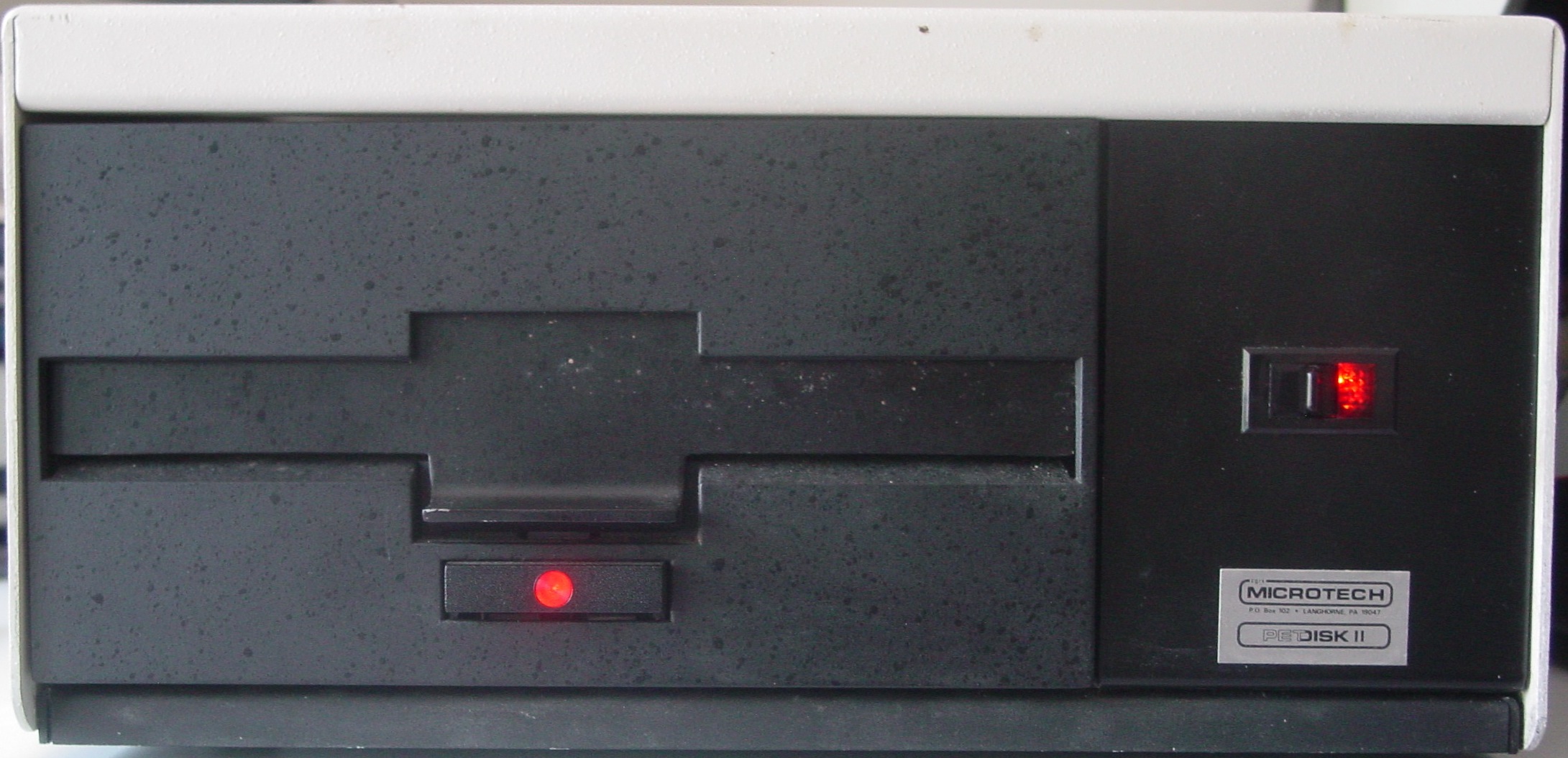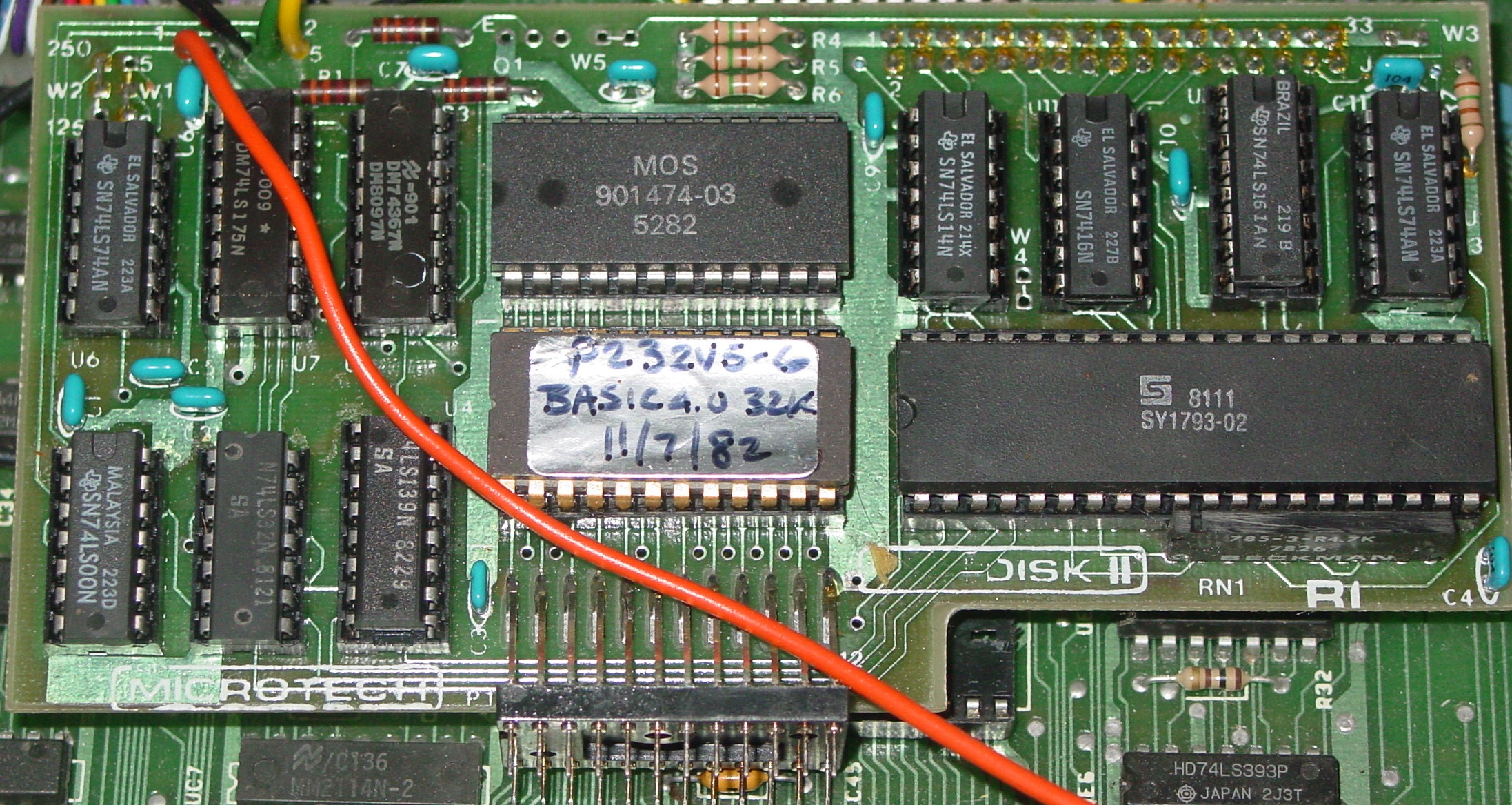CGRS Microtech PEDISK II
-
The PEDISK II (sometimes mistaken as “PETDISK”) from CGRS Microtech is a third-party floppy disk system for PET/CBM computers. Unlike Commodore floppy drives which attach externally via the IEEE-488 port, the PEDISK II installs internally into the computer. It has its own DOS that is not compatible with Commodore commands or disks. Magazine reviews state that the PEDISK II is significantly faster than Commodore floppy drives.
To install the PEDISK II, a daughterboard is installed into the CBM’s EDIT ROM socket. The EDIT ROM is relocated onto the board. The board contains a WD1793 floppy controller, a new ROM with disk code, and glue logic. The floppy drive is held in an external enclosure that attaches to the board via a ribbon cable.
The PEDISK II can support both 8″ and 5.25″ drives. Up to three drives can be used at one time but all must be the same type. The system could be purchased as a standalone controller or with drives. My unit is the model 877-1, which came with a single 8″ drive. It uses a Siemens FDD100-8 full-height mechanism.
Installed in CBM 8032 on UD7
Board Overview
Board Jumpers
Board Top Side
Board Bottom Side
Orange Clip on UD3
Overview of Clips on J9 and J4
Green and Yellow Clips on J9
Black Clip on J4 (Incorrect)Note: these photos show the clips as they were found in an 8032. One wire is not correct. The black wire as shown goes to J4 pin 21 (/PENSTRB). On the PEDISK II board, the black wire goes to the reset pin of the WD 1793. The black wire should be clipped to pin 22 on J4 (/RESET) instead.
Reverse Engineering
I temporarily desoldered all of the components from the PEDISK II board to make reverse engineering easier:
Bare Board Scan (Top Side)
Bare Board Scan (Bottom Side)Bare Board Photo (Top Side)
Bare Board Photo (Bottom Side)Reassembled Photo (Top Side)
Reassembled Photo (Bottom Side)I replaced all of the sockets and passive components during reassembly. I also installed a jumper block where the wire straps were. Before the work, entering
SYS 59904would always crash the machine. Reseating the chips did not help. After the work, it now shows the startup banner and tries to boot.See also my notes on the PEDISK II system.
Firmware
PEDISK2.BIN – 2716 EPROM that installs on the PEDISK II daughterboard. Labelled “P232V5-6 – BASIC4.0 32K – 11/7/82”. PEDISK jump table can be found at $EA00.
I am working on a disassembly of the ROM and the disk-based portion.
Software
Do you have any disks in PEDISK format? Please contact me at .
Usage
The PET starts normally with no indication that the PEDISK II is present. It is activated by entering
SYS 59904. This should print a CGRS Microtech banner and then cause the PEDISK II to try and load its DOS from disk:
The PEDISK II does not use the standard Commodore disk commands. Instead, its DOS is a BASIC wedge where each command is prefixed by an exclamation point. Before the manuals were found, the PEDISK II commands were reverse engineered from the table of BASIC tokens at $EA24 in the ROM:
!SYS: Enter “PDOS Mode”, the DOS monitor.!LOAD"filename:drive": Load a program from disk.!SAVE"filename:drive": Save a program to disk.!OPEN!CLOSE!INPUT!PRINT!RUN"filename:drive": Load and run a program from disk.!LIST: List the disk directory.
Note in the commands above that the filename syntax is the opposite of CBM DOS — the drive number comes after the filename. Also unlike CBM DOS, the drive number is always required. PEDISK drive numbers start at
0. Filenames are limited to six characters (not including the drive suffix).The implementation of
!LOADis in the ROM at $EE98. It is possible that!LOADcan still be made to work if a working boot disk is not found. The other commands are in the RAM resident portion starting at $7800. Note that the wedge will not be installed if the RAM resident portion fails to load from disk.Disk Format
The PEDISK II model 877-1 uses an 8″ single sided, soft sectored, single density (FM) floppy disk. It has 77 tracks, 26 sectors per track, and a 128 byte sector length. It can hold about 250 KB.
The manuals had not been found when the project was started, so the disk format had to be found through reverse engineering. The following clues were used:
- The ROM has limits and buffer lengths hardcoded. Tracks: 77 (ROM $EBD3), Sectors Per Track: 26 (ROM $EC74), Sector Length: 128 bytes ($ECCA).
- FD1793 pin 37 is
/DDEN(/DOUBLE DENSITY) and should be low when double density. On the PEDISK, pin 37 is high (single density). - Jumper W2 is “250” or “125”. It is set to 250. This is probably the bit rate (kbits/sec). For Single Density 8″, the bit rate is 250 kbits/sec. According to a disk formats table, all the 8″ double density formats are 500 kbits/sec. There is no 500 option on the PEDISK board.
- Advertisement in Midnite Software Gazette, Issue 11 (Feb/Mar 1983): “PEDISK Model 877 is an 8” SD floppy disk system that uses the IBM 3740 format … Eight inch SD CP/M (trademark of Digital Research) diskettes can also be read/written with the 877 system.”
The PEDISK II uses its own unique filesystem, but it is able to read sector data from IBM 3740 or CP/M single density 8″ disks.
Mechanism
The model 877-1 is a single 8″ floppy drive in an external enclosure. The enclosure houses a Siemens FD100-8 mechanism and a Power One CP206-A linear power supply.
Siemens FD-100-8 Technical Manual
Siemens FD-100-8 Schematic – Reverse engineered by Josh BensadonManuals
These manuals were provided by Bill Goble.
User’s Manual
Programmer’s ManualNewsletter
CGRS Microtech published a newsletter for PEDISK owners. Jim Oldfield helped publish it and provided the first two issues. Bill Goble provided the third issue.
PEDISK Newsletter Issue 1 (November 1981)
PEDISK Newsletter Issue 2 (January 1982)
PEDISK Newsletter Issue 3 (June 1982)Advertisements
Reviews
Review of Original PEDISK (Compute, Feb 1981)
Review of PEDISK II (The Paper, Nov/Dec 1981)
Review of PEDISK II (Midnite Software Gazette, Winter 1982)
Review of PEDISK II (Commander, May 1983)
Review of PEDISK II (TORPET, Jan 1984)


